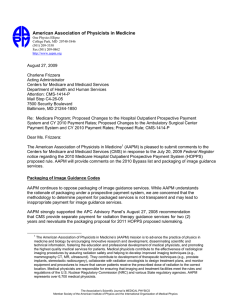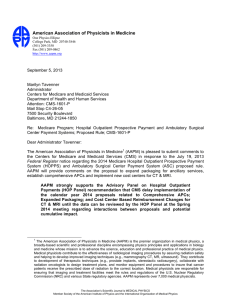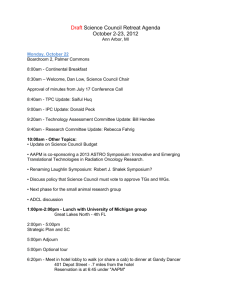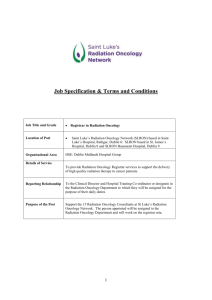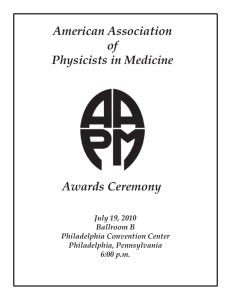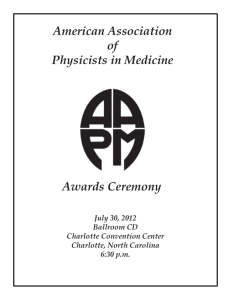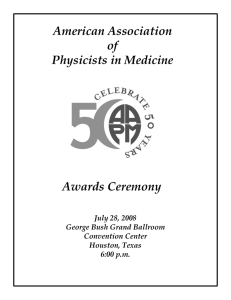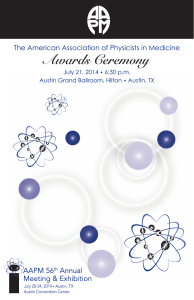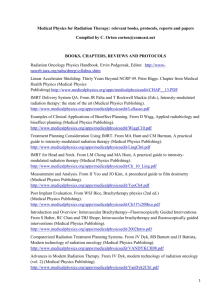Comment Letter Regarding the 2009 Hospital Outpatient Final Rule
advertisement
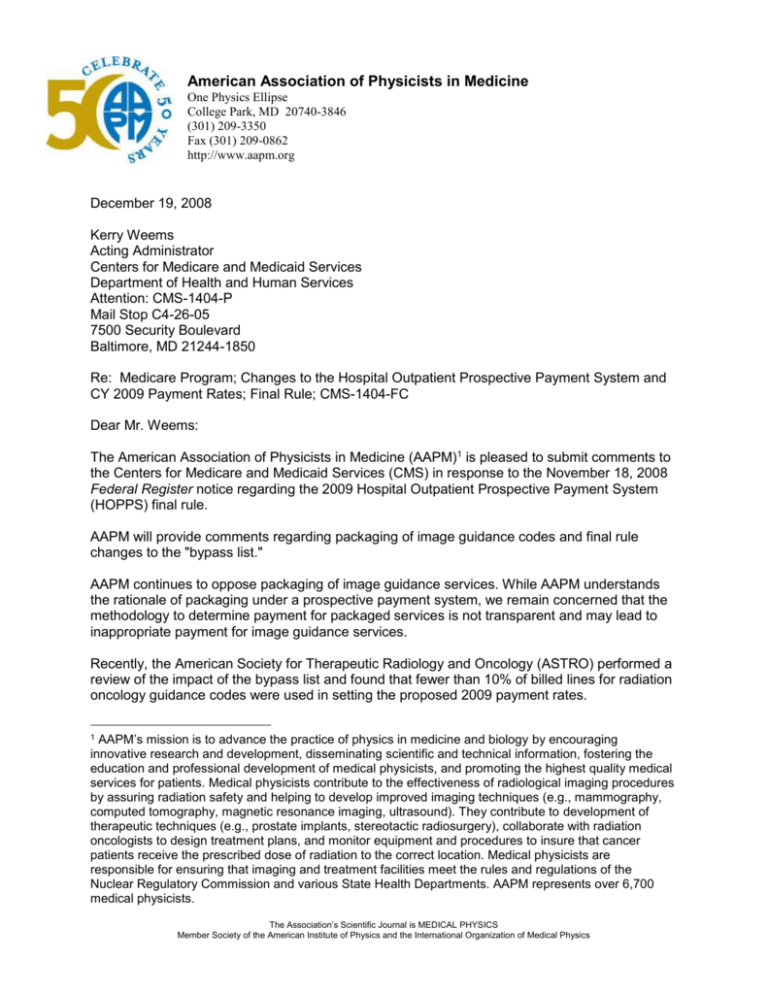
American Association of Physicists in Medicine One Physics Ellipse College Park, MD 20740-3846 (301) 209-3350 Fax (301) 209-0862 http://www.aapm.org http://www.aapm.org December 19, 2008 Kerry Weems Acting Administrator Centers for Medicare and Medicaid Services Department of Health and Human Services Attention: CMS-1404-P Mail Stop C4-26-05 7500 Security Boulevard Baltimore, MD 21244-1850 Re: Medicare Program; Changes to the Hospital Outpatient Prospective Payment System and CY 2009 Payment Rates; Final Rule; CMS-1404-FC Dear Mr. Weems: The American Association of Physicists in Medicine (AAPM)1 is pleased to submit comments to the Centers for Medicare and Medicaid Services (CMS) in response to the November 18, 2008 Federal Register notice regarding the 2009 Hospital Outpatient Prospective Payment System (HOPPS) final rule. AAPM will provide comments regarding packaging of image guidance codes and final rule changes to the "bypass list." AAPM continues to oppose packaging of image guidance services. While AAPM understands the rationale of packaging under a prospective payment system, we remain concerned that the methodology to determine payment for packaged services is not transparent and may lead to inappropriate payment for image guidance services. Recently, the American Society for Therapeutic Radiology and Oncology (ASTRO) performed a review of the impact of the bypass list and found that fewer than 10% of billed lines for radiation oncology guidance codes were used in setting the proposed 2009 payment rates. AAPM’s mission is to advance the practice of physics in medicine and biology by encouraging innovative research and development, disseminating scientific and technical information, fostering the education and professional development of medical physicists, and promoting the highest quality medical services for patients. Medical physicists contribute to the effectiveness of radiological imaging procedures by assuring radiation safety and helping to develop improved imaging techniques (e.g., mammography, computed tomography, magnetic resonance imaging, ultrasound). They contribute to development of therapeutic techniques (e.g., prostate implants, stereotactic radiosurgery), collaborate with radiation oncologists to design treatment plans, and monitor equipment and procedures to insure that cancer patients receive the prescribed dose of radiation to the correct location. Medical physicists are responsible for ensuring that imaging and treatment facilities meet the rules and regulations of the Nuclear Regulatory Commission and various State Health Departments. AAPM represents over 6,700 medical physicists. 1 The Association’s Scientific Journal is MEDICAL PHYSICS Member Society of the American Institute of Physics and the International Organization of Medical Physics In addition, ASTRO reported that more than one-third of the billed lines for Image Guided Radiation Therapy (IGRT) services were being packaged into the single bills for services that are totally unrelated to radiation oncology services, such as clinic visits. ASTRO commented that this misassignment may have occurred in part as a result of the inclusion of radiation oncology services on the bypass list. Based on ASTRO's comments, CMS examined the combination of codes that occurred on claims that contained guidance codes for radiation oncology services (i.e., CPT 76950, 76965, 77014, 77417, and 77421). CMS found that on some claims the costs of image guidance for radiation therapy services were being packaged into the costs of other services such as clinic visits, or were not available to be correctly packaged. Therefore, CMS reported that those costs were not being appropriately packaged into the radiation oncology services to which they were incidental and supportive. CMS concluded that the inclusion of radiation oncology codes that failed to meet the empirical criteria for inclusion of the codes on the bypass list was most likely the source of the problem. In the 2009 HOPPS final rule, CMS removed from the 2009 bypass list all codes in the radiation oncology series of CPT (i.e., 77261-77799) that did not meet the empirical criteria for inclusion on the bypass list. AAPM and other key stakeholders did not have an opportunity to analyze changes to the final 2009 bypass list or make recommendations that might have avoided significant payment fluctuations from proposed and final 2009 payment rates. While AAPM supports a methodology to accurately capture the costs of packaged image guidance procedures, we do not support changes to the bypass list in the 2009 final rule that resulted in the loss of approximately 1 million pseudo-single procedure claims utilized to determine payment rates for radiation oncology APCs. Removing these codes from the 2009 bypass list may have resulted in more appropriate assignment of packaged cost but it also negatively impacted final 2009 payment rates for several radiation oncology APCs. AAPM supports continued CMS analysis of the claims data for these codes, and particularly for the APCs for which the number of usable claims declined. Further, AAPM encourages CMS to establish an appropriate methodology that utilizes to the greatest extent possible multiple procedure claims for ratesetting by creating pseudo-single claims while capturing the cost of image guidance services. We hope that CMS will take this issue under consideration during the development of the 2010 HOPPS/ASC proposed rule. Should CMS staff have additional questions, please contact Wendy Smith Fuss, MPH at (561) 637-6060. Sincerely, James Hevezi, Ph.D. Chair, Professional Economics Committee James Goodwin, M.S. Vice-Chair Professional Economics Committee

